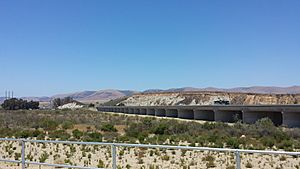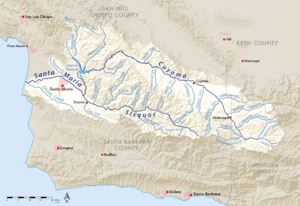Santa Maria River (California) facts for kids
Quick facts for kids Santa Maria River |
|
|---|---|

Santa Maria River as seen from a bike trail on the Santa Barbara County side, with the 101 Freeway bridge visible
|
|

Map of the Santa Maria River watershed
|
|
| Country | United States |
| State | California |
| Cities | Santa Maria, Guadalupe |
| Physical characteristics | |
| Main source | Confluence of Sisquoc River and Cuyama River South of Twitchell Reservoir 354 ft (108 m) 34°54′11″N 120°18′45″W / 34.90306°N 120.31250°W |
| River mouth | Pacific Ocean Guadalupe Dunes County Park 0 ft (0 m) 34°58′15″N 120°39′01″W / 34.97083°N 120.65028°W |
| Length | 24.4 mi (39.3 km) |
| Basin features | |
| Basin size | 1,760 sq mi (4,600 km2) |
The Santa Maria River is a river located on the Central Coast of California. It begins where two other rivers meet and flows for about 24 miles (39 km). The river ends its journey by flowing into the Pacific Ocean.
Contents
Discover the Santa Maria River
The Santa Maria River is an important natural feature in California. It helps define the landscape and supports various ecosystems. Understanding rivers like this helps us learn about our environment.
Where the River Begins
The Santa Maria River is formed when two other rivers, the Sisquoc River and the Cuyama River, join together. This meeting point is just east of the city of Santa Maria. From there, the river flows west towards the ocean.
A Natural Border
For its entire length, the Santa Maria River acts as a natural border. It separates northern Santa Barbara County from southern San Luis Obispo County. A large bridge on Highway 101 crosses over the river, connecting these two areas. There is also a Santa Maria River Fault, which is a crack in the Earth's crust that generally follows the river's path.
Water Flow and Dams
The Santa Maria River itself does not have any dams or lakes directly on it. However, one of its main branches, the Cuyama River, does have a dam. This dam creates the Twitchell Reservoir. The United States Bureau of Reclamation built Twitchell Dam. Its main jobs are to help control floods and to refill the underground water supply, called an aquifer. This process is known as groundwater recharge.
The Sisquoc River, another branch that forms the Santa Maria River, is special. It flows freely without dams and is part of the National Wild and Scenic Rivers System. This means it is protected for its natural beauty and importance.
The River's Water Levels
For most of the year, the Santa Maria River has very little water flowing in it. Sometimes, it can even look like a dry riverbed. However, during winter storms, the river can swell up dramatically. It can carry a lot of water, showing its power and importance in the local water system.

